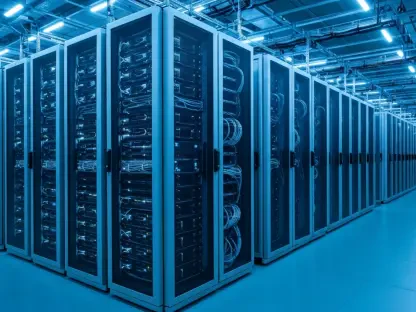The landscape of data centers is undergoing a transformational shift, marked by a significant surge in capital expenditures (capex) driven primarily by the demand for AI-accelerated servers. These servers, designed to handle intensive AI workloads, are becoming a cornerstone of modern data centers. The rise of AI technologies, particularly those involving generative AI systems, is necessitating the adoption of more powerful and specialized hardware, leading to an unprecedented increase in data center spending. As these AI systems evolve, the computational power required to support them continues to grow, compelling data centers to invest significantly in upgrading their infrastructure.
The Boom in Data Center Capital Expenditures
Over the past year, data center spending has seen a remarkable increase, with a near 50% surge in capex in the second quarter of 2024 compared to the same period in the previous year. This upward trend is largely attributed to the rapidly growing need for AI-ready hardware, specifically GPU-accelerated servers. Industry analysts project this growth to continue, although at a slightly decelerated pace, with an overall expected growth of 35% in capex for 2024. The primary driver behind this surge is the expanding implementation of AI workloads across various industries. From natural language processing to complex data analysis, AI systems require sophisticated computational power, which traditional servers are increasingly unable to provide. As a result, data centers are investing heavily in upgrading their infrastructure to incorporate AI-accelerated servers.
The significant investment in AI servers is also indicative of the strategic shift towards future-proofing data centers. As AI technologies continue to evolve, so does the necessity for infrastructure capable of supporting these advancements. Traditional servers simply cannot keep pace with the demands of modern AI applications, prompting data centers to prioritize GPU-accelerated servers. These investments are not only meeting current demand but are also setting the stage for future growth as AI applications become more prevalent and complex. The result is a data center industry in a state of rapid evolution, driven by the relentless progress of AI technology.
Dominance of AI Servers
AI servers, particularly those equipped with GPUs, are pivotal in supporting the high computational needs of AI applications. These servers are essential for handling tasks like training AI models, which demand enormous processing power and parallelism. The market for AI servers is experiencing accelerated growth, with experts forecasting significant market valuation in the coming years. According to Omdia, the global server market is expected to reach $196 billion by 2027, with AI servers comprising a substantial portion of this valuation. The demand for AI-specific hardware is so robust that it is outpacing the growth of general-purpose servers. With a compound annual growth rate (CAGR) of 31% from 2023 to 2028 for AI servers, compared to a mere 3% for general-purpose servers, the trajectory clearly favors AI-accelerated hardware.
This disparity in growth rates underscores the critical role that AI servers play in the current tech ecosystem. AI-driven applications are exponentially expanding, necessitating servers that can manage vast amounts of data swiftly and efficiently. The superiority of AI servers over general-purpose servers in handling AI tasks is apparent in their ability to provide the required parallel processing power. This is especially relevant for tasks that involve large-scale machine learning and deep learning models, which are becoming increasingly common in industries ranging from healthcare to finance. As such, the emphasis on AI servers is expected to remain a focal point of data center strategies for the foreseeable future.
Impact on Networking and Related Technologies
The deployment of AI-accelerated servers has a cascading effect on other technological investments within data centers, most notably in networking. AI workloads, especially those involving interconnected clusters for training large models, require higher bandwidth and more advanced networking solutions. This need for enhanced network capacity is driving additional investments in networking technologies, ensuring that data centers can adequately support the increased data throughput and communication demands of AI applications. Furthermore, the rise of AI-accelerated servers is fostering innovations in network architectures. New designs and protocols are being developed to optimize data flow and reduce latency, which are critical factors in maintaining efficient AI operations. As AI continues to integrate deeper into various sectors, the interplay between server capabilities and networking infrastructure will become increasingly vital.
This trend is not limited to hardware alone; it extends to the software and firmware that support AI operations. Innovations in network architectures aim to streamline data processing and minimize latency, a crucial aspect when dealing with real-time AI applications. As a result, the evolution of AI servers is symbiotically linked with advancements in networking technologies. The enhanced network infrastructure ensures that the high-performance capabilities of AI servers are fully realized, leading to more effective and efficient AI-driven processes. This interconnected development signifies a holistic growth within the data center industry, where advancements in one area drive progress in another, resulting in an overall more robust and capable technological ecosystem.
Strategic Players and Market Dynamics
In the competitive landscape of AI-accelerated servers, several key players are leading the charge. Nvidia, for instance, has established itself as a dominant force in the market, with its data center business significantly outpacing traditional server vendors like Intel. Nvidia’s GPUs are highly sought after for their superior performance in AI tasks, making the company a key player in this burgeoning market. Technical giants, or hyperscalers, like Google and Amazon are also major contributors to the growth of AI-accelerated servers. These companies are developing custom ASIC (application-specific integrated circuit) chips tailored to their specific needs, further pushing the envelope of AI hardware capabilities. In addition, other notable chipmakers like AMD and Huawei are investing heavily in AI technologies, creating a diverse and competitive market environment.
The competitive dynamics within this market reflect broader trends in tech innovation and strategic development. Companies like Nvidia have gained a significant edge by focusing on specialized AI hardware, a strategy that has paid dividends as the demand for AI-powered solutions continues to escalate. Meanwhile, hyperscalers are leveraging their vast resources to develop bespoke solutions that enhance their operational efficiency and provide a competitive advantage. This approach not only positions them well within the AI server market but also sets the stage for future technological advancements. The robust competition and investment in AI technologies from various industry players indicate a vibrant, rapidly evolving market landscape.
Looking Ahead: Market Stabilization and Future Projections
The landscape of data centers is experiencing a transformational shift, highlighted by a notable increase in capital expenditures (capex). This surge is largely driven by the rising demand for AI-accelerated servers, crucial for handling intensive AI workloads. These specialized servers are becoming fundamental components of modern data centers. The proliferation of AI technologies, especially generative AI systems, mandates the use of more powerful and tailored hardware, leading to a remarkable growth in data center spending.
AI systems are evolving rapidly, and the computational power required to support them is expanding. This ongoing advancement forces data centers to continuously invest in updating their infrastructure. As generative AI and machine learning applications grow in complexity, data centers need to accommodate the increased power and performance requirements. This means not only investing in cutting-edge servers but also enhancing cooling systems, power distribution, and network capabilities to maintain optimal performance and efficiency.
In essence, the drive toward advanced AI capabilities is reshaping the way data centers operate, resulting in significantly higher capital investments. This trend underscores the critical role that AI-accelerated servers and robust infrastructure play in the future of data processing and storage, positioning data centers as pivotal hubs for technological innovation.









